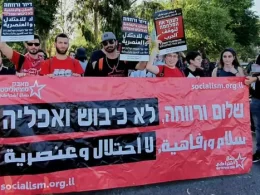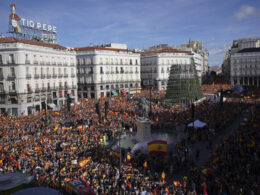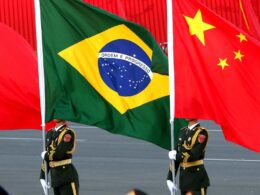The Syrian regime has dramatically stepped up its savage military onslaught on civilians in Homs and other areas. Recent days have seen the worst upsurge in bloody repression since the start of the uprising last March. Reports indicate that local communities in towns and city suburbs have been shelled indiscriminately, with hundreds of people massacred in Homs. A number of areas have been under military siege, with accompanying cuts in power, water and other supplies.
The ‘concern’ for the plight of Syrian civilians by representatives of western imperialism and the Arab elites and their condemnation of Russia and China for refusing to demand the removal of the Syrian president is total hypocrisy. No similar concern is shown when atrocities against civilians are carried out by their own or allies’ military forces either at home or abroad, whether in Iraq, Afghanistan, Bahrain, Gaza or elsewhere.
Incredibly brave and tenacious, hundreds of thousands of people across Syria have been turning out time and time again to demonstrate, largely unarmed, knowing that some may be killed by snipers and others maimed or detained and tortured. While substantial areas of the two largest cities, Damascus and Aleppo, appear to be relatively stable, some of the suburbs have been among the areas where mass rallies have taken place. Over 7,000 civilians are estimated to have died so far, including hundreds of children. Reports have indicated that the injured can’t even go to hospitals for treatment, as they will be sought out there and detained or killed and that even activist groups that have renounced the use of arms or violence in any form are prime targets for the state’s murderers and torturers.
The Baathist regime of president Bashar al-Assad has overwhelming military advantage, but despite this, communities in revolt are running pockets of resistance scattered across the country. For instance the town Zabadani near the Lebanese border was said to have put up ferocious resistance to the state military forces and declared itself run solely by its own newly elected council. There was an uneasy temporary truce, with the town remaining surrounded by the Syrian army, but it has now again been bombarded by the army.
The government forces have been concentrating on trying to keep control of the third and fourth largest cities, Homs and Hama, and the eastern suburbs of the capital Damascus. But with indications that many areas are in open rebellion, the army can’t be everywhere at the same time; where it manages to retake control it may not be able to hold it when it decides to redeploy elsewhere.
Trying to protect the demonstrations and areas under siege is the growing number of army defectors and civilians who are joining local-based groups of the Free Syria Army. But this ad hoc force, remotely coordinated from a refugee camp in Turkey, is estimated to be only 10-20,000 strong at present and desperate for more arms and equipment. It is up against a state army of 500,000 (including reservists) which for now is mainly holding together. How long it will stay like this is highly questionable, especially as a majority of the rank and file are from the majority Sunni population, substantial sections of which have hostility to the minority Alawite-led regime.
Without convincing evidence, the government has accused foreign terrorists of perpetrating atrocities, while at the same time there are many reports that its own military forces have extensively employed elite fighters from abroad to do some of its worst deeds that it dare not trust to the army rank and file. For example, Mahmood Haj Hamad, a high ranking defector from the defence ministry, claimed that a slush fund existed for the regime to pay thousands of streetfighters from Iran and Hezbollah in Lebanon as well as the Shabiha paramilitary gangs who spearhead some of the torture and killing sprees.
Weakening base
The shocking brutality of the regime’s forces reveals its fundamental weakness; it is struggling to maintain its social base and so is trying to crush all opposition through inflicting sheer terror. But 11 months into this strategy it is failing to subdue the uprising, and escalating its offensive will fuel even greater anger. Conversely, as the opposition is also unable at present to gain the upper hand, a stalemate situation is enduring.
Thirty years ago Assad’s father presided over the slaughter of tens of thousands of Sunnis in Hama to crush a rebellion, but the scale of the opposition movement now is greater and more entrenched. The Baathist regime can no longer rely on its social provisions of the past – free health care, education, subsidised food – to give it a secure support base. These workers’ gains have been eroded and high poverty and unemployment have become endemic, to become the driving force of the hatred of a layer of the population towards the corrupt ruling elite today.
During a visit to Damascus this week by Russia’s foreign minister, Assad once again paid lip-service to wanting ‘dialogue’ with the opposition and democratic reforms such as a new constitution, but few people believe that he will deliver anything significant and meanwhile the vicious military crackdown goes on.
Although events could develop very rapidly towards a head, it is also possible that the struggle could continue to be of a prolonged nature, with even worse onslaughts by the government to come, until a tipping point is eventually reached in favour of the opposition movement or the ruling elite itself decides to remove Assad. Fearing how far the revolutionary movement could go, those around Assad could engineer his exit in order to try to preserve their vast wealth and privileges and the state institutions that protect them, including the army and police. They also fear the ever deeper crisis that the economy is descending into, due to the world economic crisis but worsened by sanctions from western imperialism and the Arab League, a nosedive in tourism, the diversion of public money to the military and a loss of tax revenues due to the uprising. As a result there are workplace lay-offs and closures, fuel shortages, rising prices and the currency is plunging.
Since the start of the Arab Spring, most in the elite and a significant layer of the population (including many Sunni business owners) have clung to Assad’s continued rule in the belief that he offers the best chance of stability. But when this belief evaporates, support could be withdrawn very quickly, as was seen in the case of Gaddafi in Libya when Tripoli fell out of his hands.
Syria’s former ambassador to Sweden fled to Turkey in December and denounced Assad’s regime, saying that many inside the Syrian government secretly wanted Assad to fall: “People even high up aren’t loyal to the government but …. They are scared for their lives and families”, and regarding the military: “Many officers would like to defect but there’s nowhere safe to go”.
The limited result for ordinary people that a transfer of power within the elite would be, can be seen in Egypt and Tunisia. The exact composition of those at the helm was changed, but the capitalist system with its massive chasm between the rich and the poor remained in place.
International response
That the 22 country Arab League and also neighbouring Turkey – Syria’s biggest trading partner – demanded that Assad should go, was a major blow to the Syrian regime. Assad’s only firm ally in the region is Iran, and to a lessor extent Iraq and Lebanon. Regarding global support, in the UN security council Russia and China refused to support a resolution demanding that he quits, in keeping with their competition with western powers for spheres of influence and unease about the possible consequences for their interests post-Assad.
The Russian ruling class has particularly close links with the Syrian Alawite-dominated elite, including major investments in Syria and arms deals – $4 billion of fighter jets and missiles were recently sold to Syria. Russia’s only naval base outside the former Soviet Union is at the Syrian port Tartus, a foothold in the Middle East it doesn’t want to lose. The protective attitude of the Russian leaders towards the Syrian elite (not especially to Assad himself) stems from these connections.
With the failure of the UN resolution, a ‘Friends of Syria’ grouping is now being cobbled together to pursue the interests of the world powers that want to see Assad removed. The Arab League pulled out its temporary 165 observers from Syria during the last weekend of January, after predictably failing to stop the bloodshed. The hypocrisy of this tokenism by the super-rich Arab autocracies was shown in their appointment of Sudanese general Mustafa al-Dabi to head the mission. Dabi used to be the military intelligence chief of Sudan’s president Omar al-Bashir while genocide and other crimes were being committed in Darfur.
What foreign interventions will be tried next? In Libya it was propaganda about a possible massacre by Gaddafi’s forces in Benghazi that gave Nato the excuse to intervene militarily (mainly airforce) on the side of the opposition. Some left political organisations internationally made the mistake of welcoming that intervention. The CWI on the other hand pointed out that there wouldn’t necessarily be less civilian bloodshed as a result of it and that its aim was not to protect civilians but to achieve an outcome to the conflict favourable to western imperialism. That position was proved correct. There was reason to believe that Gaddafi’s forces would not have been able to carry out a massacre in Benghazi, but there were atrocities subsequently committed by the opposition forces in many areas of Libya, as well as by those of Gaddafi. As Seamus Milne put it in the UK Guardian (8.2.12), as well as an increased death toll, the legacy of foreign intervention in Libya was: “mass ethnic cleansing, torture and detention without trial, continuing armed conflict, and a western-orchestrated administration so unaccountable it resisted revealing its members’ names”. And the intervention was used to open the door to further foreign exploitation of the country’s productive and natural resources.
Now the western media is echoing desperate pleas from Syrian civilians for foreign intervention to protect them. However, while billions of ordinary people across the globe are completely genuine in their concern and desire to support any meaningful assistance that can be given to Syrians who are being slaughtered, the motives and interests of the Arab elites and imperialist ruling classes are entirely different. They view the situation from the standpoint of their own influence and wealth, so any intervention would be in their own class interests and not those of the Syrians being butchered. Which imperialist power does not have more blood on its hands than even Bashar al-Assad when you look at what has happened in Iraq, Afghanistan, Chechnya and so many other ‘interventions’? The chief crime of the Syrian regime in the eyes of western imperialism and its allies is not its brutality, but its alliance with their enemy state Iran.
In any case, foreign military intervention is fraught with great difficulties for the regional and world powers. Ground troops, after the experiences of Iraq and Afghanistan and with the complexities of the situation in Syria are not seen as an option. Bombardment from the air, or even just enforcement of a no-fly zone, would be much harder than it was in Libya, because of the dissipated nature of the opposition, the more varied terrain, the relatively sophisticated anti-aircraft defences in Syria, not to mention the vociferous opposition of Russia, China and Iran and the possible consequences in the wider region.
The most that may perhaps be considered in the short term is protection/buffer zones near the Turkish border to contain the flow of refugees, enforced by Turkey’s military forces, or on the border with Jordan. Also some governments are intent on sending covert funding and arms to the Syrian opposition organisations that they are trying to influence. These include Qatar and Saudi Arabia where the elites are keen to counter the Iran-Syria-Hezbollah axis and where pressure has built up from below to aid the Sunni majority in Syria. The hypocrisy of these elites knows no bounds when the absence of democracy in their own countries is looked at!
But this doesn’t mean that other regional and world powers will not be drawn into the conflict in a more direct way militarily. They are under huge pressure to be seen to be doing something – especially countries with Syrian émigré populations – and they don’t want to cede influence to their competitors. And things do not always go to plan, crises can escalate unexpectedly; with the volatility in the region a devastating war situation could develop and draw in interventions previously not contemplated.
Workers’ movement
After decades of repressive dictatorship and suppression of opposition political parties and genuine trade unions, workers in Syria have had to enter into struggle without having their own independent organisations. The activists and supporters of the uprising are demanding freedom from corrupt and despotic rule, but underlying the discontent in Syria and across the Arab world are the material issues of high unemployment, increased poverty, poor housing etc – byproducts of capitalist economic crisis and neoliberal policies.
‘Change’ is demanded by the two main opposition political umbrella organisations that have been formed, the Syrian National Council and the National Coordination Body, but they are broad bodies that are rife with division and that want to preserve existing state institutions including the military. They don’t have a programme and strategy that can unify and develop the opposition movement on the ground. They call for a more equitable (capitalist) society, whereas only a call for a democratic socialist society could unite all sections of workers around a programme for full employment, well funded services, decent homes and other necessities.
Although it will be a huge relief to a layer of the Syrian working class and middle class when Assad is eventually forced out and the savagery of the crackdown ends, it won’t be enough if another big business led government assumes the reins of power, as workers in Tunisia and Egypt are now discovering following the overthrow of their autocratic presidents. The viewpoint is different for the sections of Syrian society that don’t want to see the fall of Assad, partly out of fear that there will a wave of discrimination against certain minorites or a terrible civil war.
Without a new workers’ formation being built that adopts a programme showing a clear way forward on the basis of workers’ unity, the dangers of sectarian division in Syria are potentially great, and are already apparent in areas where the government appears to have deliberately provoked them. The worst clashes of this nature have been in Homs, where there have been reports of pro-Assad forces giving arms to Alawite communities to use against others, and encouraging kidnappings and killings that foster division and cut across united struggle against the regime.
With the complex make-up of Syria’s population – a Sunni majority alongside Christian, Alawite, Druze, Shia, Kurdish and other minority ethnic or religious sections – a programme that advances the interests of all working people and guarantees full democratic rights for minorities is essential.
Democratically run workers’ defence committees urgently need to be built in every community and workplace, with the right to distribute arms. Alongside these, workers’ committees are needed that can organise and link together regionally and nationally to build a mass revolutionary movement capable of reaching its goals. This means preparing for and developing an escalating programme of general strikes, occupations, and other actions.
It is important for the movement to firmly reject any imperialist intervention or interference. It needs to appeal to rank and file Syrian army soldiers with a socialist programme for public ownership and workers’ control and management of the key industries, that would inspire them to join the side of the revolution, as the Bolsheviks did in Russia in 1917.
Heroic though the fighters in the Free Syria Army are, they may become tools of a replacement group of pro-capitalist ‘leaders’ as happened to the opposition militias in Libya, unless they organise democratically as part of a mass independent workers’ movement that mobilises the full power of the working class and poor.












